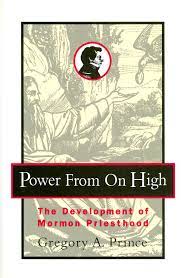A Development of Mormon Priesthood Gregory A Prince 1995 Signature Books

This is a relatively short read, packed with information presented in an authoritative yet easy manner to digest. The author lays out evidence without criticism, in this respect it is a safe read for any faithful member. The advantage of Prince’s book on the subject matter is it’s brevity compared to D Michael Quinn’s extensive, ‘Origins of Power’ or Charles R Harrell’s expensive ‘This is my Doctrine’ The Development of Mormon Theology
The first chapters theme is Authority. Prince categorises priesthood development in phases
1.Implied Authority, Sept 1823 – 1829
Translating the plates into the Book of Mormon implied Smith’s credentials as a prophet, as Moroni’s visits never bestowed formal authority
2.Angelic Authority April 1829 – Oct 1830
Almost six years later angelic visitors bestowed authority on Smith and Cowdery by the laying on of hands. In the modern church we recognise that by authority we mean priesthood.
3.High Priesthood, Dec 1830 – Nov 1831
Sydney Rigdon believed those who ministered to him lacked the power of the early apostles, in the ensuing months indications of an endowment of power were given in Smiths revelations. On 3 June 1831 the elders met and witnessed some extraordinary incidents, Pentecostal in nature. The High (Melchizedek) priesthood was introduced for the first time and conferred on several of the Elders thereby constituting a new order by ordination. The phrase Melchizedek priesthood was not used as being co-identical in respect of the term ‘High Priesthood’ until 1835, any reference to it being used earlier is retrospective.
4.Organisational Consolidation, Nov 1831 – Mar 1836
A mixture of offices and functions emerged during this period, Joseph as first Elder, Oliver as second Elder, the introduction of a First Presidency, appointed from the High Priesthood, a President of the High Priesthood, holding power to authorise all other officers in the church by the laying on of hands instituting a means of centralising authority. In 1834 a High Council of High Priests was organised strictly judicial in function. The institution of both the quorum of twelve and first quorum of seventy.
5.Elijah and the Fullness of Priesthood Apr 1836 – Apr 1844
We are familiar today with the notion of priesthood being restored on the banks of the Susquehanna river in 1830 but in order to utilise it with power and divine approval specific keys are requisite, provided in full by angelic visitors to Joseph in the Kirtland temple culminating with Elijah.
In the chapter ‘Authority’ Prince believes Smith came to understand the implications of his visionary experiences, changing policy and doctrine to reflect his own understanding. In 1836 he sees Elijah and receives keys but it took him eight further years to move Elijah from obscurity to virtually unparalleled importance. Prince suggests this development occurred through the processes of reflection, prayer and gradual enlightenment. This appraisal sits comfortably with the Lord’s promise to the Church of Christ on 8 Aug 1833 that God would “give unto the faithful line upon line precept upon precept”.
The power of Prince’s authority categorisation is in highlighting the restoration of the primitive church (6th Article of Faith) as not being a once only process, a common theme that Russell Nelson is continuing. Why couldn’t it have been instituted in its original form in one go? Why do we witness Joseph stumbling along creating doctrine and offices, then changing them. This evolving process was a contributing factor in the disaffection of David Whitmer who said we had all the authority we needed in 1830.
Power from on High explores in later chapters the development of priesthood offices, ordinances, the endowment which I found particularly interesting as the concept begins with presenting power to affect earthly situations such as healing, then changing to effect status in the afterlife through sealings. He explores briefly the Second Anointing ordinance, the judicial systems of the church and the very sparse references made by Joseph with regard to women and the priesthood.
Alongside the history of priesthood development I believe it useful to provide a doctrinal basis on which to view its transformation. This can be achieved by asking one question, is it just policy or mode of practice that is changing or is it doctrine? I include a definition of doctrine as ‘a belief held and taught’ and a recent statement on 2 April 2022 at the women’s session of general conference by Prophet elect Dallin H Oaks. “The Gospel of Jesus Christ does not change. Gospel doctrine does not change”. A central tenet of LDS faith presented in the 5th Article of Faith states “We believe a man must be called of God, by prophecy, and by the laying on of hands by those in authority to preach the Gospel and administer in the ordinances thereof. A second key question for reflection is from which moment in time did the church begin to adhere to this tenet.